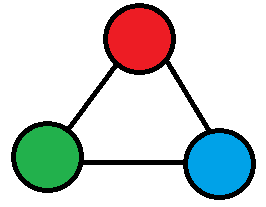Algorithms: Balancing
Balancing in algorithms refers to minimizing the complexity of an algorithm by making sure that its constituent parts share the load efficiently. It is not a technique for solving problems. Instead it helps us understand how an existing solution may be optimized.
The theory of balancing
Say there is a problem of size \(n\). The problem is such that it can be broken down into a sequence of smaller problems. There are many ways the problem can be broken down:
Solve the problem in 1 chunk: $$T(n) = f(n)$$
Or solve the problem in chunks of 5: $$T(n) = f(5) + f(n/5)$$
Of course, the relations above are not unique. There are a multitude of ways that problems can be abstracted. But the question arises: what division of load is best?
Let’s assume we want to break down the problem into \(g(n)\) chunks. Then the size of the sub-problem becomes \(n/g(n)\). The time to solve the problem becomes: $$T(n) = f(g(n)) + f(n/g(n))$$
In \(big-O\) notation: $$O(T(n)) = O(f(g(n))) + O(f(n/g(n)))$$
We need to minimize \(O(T(n))\). Notice that the sum will be dominated by whichever term is larger on the right hand side. Which means that \(f(g(n))\) and \(f(n/g(n))\) must be within a constant factor of each other. Essentially, in \(big-O\) terms: $$f(g(n)) = f(n/g(n))$$
Solving this for \(g(n)\) gives us the ideal size for partitioning the problem. For simplicity, assume that \(f(n) = n\), then: $$g(n) = {n \over g(n)}$$ $$\therefore g(n) = \sqrt{n}$$
Example: The egg dropping problem
Problem: Say you have 2 eggs and a building with \(n\) storeys. You want to find the storey that will cause the egg to break when dropped from it. What is the fastest way to figure it out?
Solution: A trivial approach is to drop one egg from storeys 1 to \(n\) until it breaks. This is going to take \(n = O(n)\) attempts. Good, but we can do better.
There are two eggs. Let’s drop one egg every 5 storeys. Then if the egg breaks on the \(k^{th}\) attempt we will know that the ‘fatal’ storey is between \((k-1)\times 5\) and \(k \times 5\) storeys. Then the second egg will be dropped from the 5 storeys from \((k-1)\times 5\) to \(k \times 5 - 1\). Therefore the total attempts would be: $${n \over 5} + 5$$
Which is less than \(n\) but in \(big-O\) notation has the same complexity: $$O({n \over 5} + 5) = O(n)$$
Our approach with using two eggs is sound. It is reducing total attempts. Let’s generalize the solution. Say the egg is dropped every \(g(n)\) storeys for a total of \(n/g(n)\) attempts. Then, like before, the second egg will only be dropped \(g(n)\) times. This gives the total attempts as: $${n \over g(n)} + g(n)$$
To minimize the total complexity (attempts) the two stages of the solution need to be equally partitioned so one stage does not dominate the other. $$\therefore {n \over g(n)} = g(n)$$ $$g(n) = \sqrt{n}$$
Thus if the first egg makes \(\sqrt{n}\) drops over the same interval, then the second egg will have to make only \(\sqrt{n}\) drops, giving the total of: $$\sqrt{n} + \sqrt{n} = O(\sqrt{n}) \lt O(n)$$
Example: Graph colouring
Problem: Colour a 3-Colourable graph in polynomial time with as few colours as possible.
Solution: A graph is said to be \(n\)-colourable if all vertices can be assigned 1 of \(n\) colours without adjacent vertices having the same colour. Graph colouring is an NP-Complete problem (except for 1 and 2 colouring). This means that an optimal solution cannot be found in polynomial time. Colouring a 3-colourable graph with exactly 3 colours might be hard, but we can attempt to use as few colours as possible in polynomial time.
One approach is called Greedy colouring. We look at all vertices in a sequence. Each vertex is assigned the first “available” colour. A colour is “available” if it is not assigned to any of the vertex’s neighbours. So if a graph has a maximum degree \(d\), then the worst case scenario for greedy colouring will take \(d+1\) colours.
The greedy approach, however, is not leveraging what we know about our graph: it is 3-colourable. Which means that every vertex’s neighbourhood is 2-colourable! 2-colouring is a simple problem. Essentially do any traversal of a graph and switch between 2 colours for each new vertex. We can use this to convert our problem into a sequence of 2- and greedy- colourings.

Here is how the new solution works: consider all vertices of degree \(\gt g(n)\). For each such vertex, 2-colour its neighbourhood. Never use those colours again. Delete the neighbourhood from the graph. Greedily colour the remaining graph. The 2-colouring step will happen at most \(n/g(n)\) times (since we remove at least \(g(n)\) vertices each step). So it will use \(O(n/g(n))\) colours. After the 2-colouring step, only vertices with degree < \(g(n)\) will remain, which will take \(O(g(n))\) colours. So the total number of colours will be: $$O({n \over g(n)}) + O(g(n))$$
Balancing both stages gives us: $${n \over g(n)} = g(n) \Rightarrow g(n) = \sqrt{n}$$
Therefore, 2-colouring all vertices with degree \(\gt \sqrt{n}\) and greedy colouring the remaining vertices will take \(O(\sqrt{n})\) colours. This is called Widgerson’s Algorithm after (surprise!) Avi Widgerson.
Balancing may not apply to all approaches. Nonetheless it is a powerful tool for analysis of algorithms.
This article was written from my notes of Dr. Jeremy Spinrad’s excellent lecture on balancing.
≡
Ibrahim Ahmed